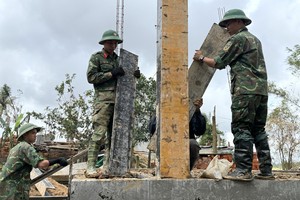
As a result, additional investment costs are incurred, traffic safety is compromised, and the development of individual localities and the entire region is hindered.
Lack of decisiveness in compensation
Construction of the Rach Mieu 2 Bridge, spanning the Tien River and connecting Tien Giang and Ben Tre provinces, commenced in August 2022 with the aim to alleviate the increasingly severe traffic congestion on the Rach Mieu Bridge, facilitating smoother transportation and commerce for residents, and contributing to the economic development of the Mekong Delta.
However, despite the government's decision to extend the bridge's opening date to 2026 (from the original 2025 target) and increase the investment by VND 1,600 billion, the project's construction progress remains sluggish.
At the construction site, numerous pieces of construction equipment, including bulldozers, trucks, and rollers, remained idle. In the temporary housing area for construction workers, only a few workers were seen coming and going. Additionally, many residential houses, food stores, and utility poles within the project area had yet to be relocated or cleared.
According to the My Thuan Project Management Board - the investor of the Rach Mieu 2 Bridge project, the project's progress has been delayed. Construction activities have faced numerous difficulties due to Tien Giang province's failure to hand over sufficient land or due to problems with land clearance. This has resulted in difficulties for construction vehicles to access the site and has hindered construction efforts.
As of now, more than 20 households have yet to hand over their land, along with one high-voltage power pole and 13 medium and low-voltage power poles that have not been relocated. Despite numerous written requests and discussions, Tien Giang Province has repeatedly promised to complete land clearance and handover by June but recently announced a delay until July. Therefore, the investor is still awaiting the handover of land.
In Can Tho City, many significant transportation projects are currently underway, but work on many projects in the city are behind schedule due to a sand shortage; for example, the Western Ring Road and provincial road DT 923. The lack of sufficient sand for leveling has forced contractors to focus solely on bridge construction, while road construction has been delayed and some sections have even come to a standstill.
Can Tho City's Department of Transport Director Le Tien Dung has stated that in response to the current situation, the city has recently held meetings with the provinces of Vinh Long, Tien Giang, Dong Thap, and An Giang to request their support in providing sand for leveling as a commercial transactions.
However, there's still no clear solution to the sand shortage problem. While sand sources exist, local authorities are currently prioritizing the supply for expressway projects before allocating it to local roads. In Can Tho City alone, ongoing expressway projects require approximately 4 million cubic meters of sand," said Mr. Dung.
Many projects are thirsty for capital
While major transportation projects are facing delays due to sand shortages and land clearance issues, many rural transportation projects in the Mekong Delta region are also progressing slowly due to a lack of funding. In Can Tho City, specifically in Phong Dien District, over 30 rural roads are in disrepair and need upgrading but cannot be implemented due to insufficient funds. A representative from the Phong Dien District People's Committee stated that most of the rural roads in the area run along large rivers and canals, making them susceptible to erosion and damage each year.
However, the annual funding allocated to the district for this purpose is just over VND10 billion (US$393,469), which is insufficient to carry out the necessary repairs.
He added that faced with this reality, in recent years, the locality has organized efforts to mobilize additional social capital, but it has been very difficult.
Deterioration of many rural roads without timely maintenance not only poses dangers and inconveniences for people's travel but also significantly impacts the local economic development, said a representative from the Phong Dien District People's Committee.
Tran Van Thoi District of Ca Mau Province currently has a total of approximately 18 kilometers of rural roads that are damaged, sunken, or eroded, including 14 kilometers of concrete roads. In addition to causing difficulties in transportation for local residents, the lack of timely repairs to damaged rural roads has also caused farmers in the area to suffer, as their agricultural products are being undervalued by traders due to transportation difficulties.
Vice Chairman Kieu Minh Tieng of the People's Committee of Tran Van Thoi District stated that the estimated cost to repair the aforementioned damaged roads amounts to hundreds of billions of Vietnamese dong, while the allocated budget is quite modest.
The locality has also tried many ways to mobilize social resources but to no avail. As a last resort, the district recently sent a petition to the People's Committee of Ca Mau Province and the Provincial Department of Planning and Investment to consider and provide support. In the meantime, while waiting, the district has implemented a solution of using temporary wooden barriers on the eroded roads to prevent further erosion and reduce the risk of accidents and ensure the safety of people traveling," said Mr. Tieng.
According to the My Thuan Project Management Board, the government's decision to allow the exploitation of sea sand for filling has partially addressed the 'sand shortage' in major projects. However, there are still many challenges and difficulties ahead, as not all sea sand from any location is suitable for filling. Recent testing and analysis results have shown that only the sand source in the Tra Vinh and Soc Trang coastal areas is suitable and has abundant reserves, but whether it can meet the actual long-term demand remains a question.
Moreover, the construction of expressways is ongoing, while the sea sand exploitation period can only take place from March to October, and it is difficult to exploit during the remaining months due to the rainy season, storms, and frequent low-pressure systems.
























